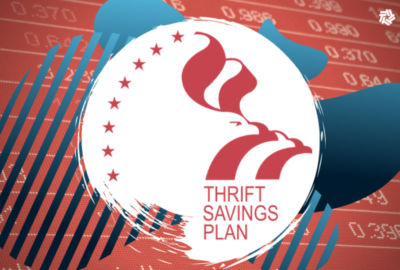TSP millionaires are busting out all over
"If you're a federal employee that's strictly investing in the G Fund. You will not be a TSP millionaire," said Abe Grungold.
The stock market continues to defy logic, something it seems to do best. Now some 117 thousand federal employees and retirees have Thrift Savings Plan accounts worth more than a million dollars. There ought to be many more. At least, that’s what federal retiree and financial advisor Abe Grungold says. He joined to discuss more.
Interview transcript:
Abe Grungold Yes, Tom, that’s not even 2% of all the active participants in the TSP. That number should be somewhere between 3 and 5%. With the salaries that federal employees are earning, there’s no reason that number shouldn’t be higher. And I can attribute the failure of the larger numbers due to two personality traits that federal employees tend to have. One is fear. And the second one is procrastination.
Tom Temin Okay, so let’s start with fear. That sounds like FUD, fear, uncertainty, doubt. What are they afraid of, do you think?
Abe Grungold So federal employees, unfortunately, I worked in four different federal agencies, and I would hear the same thing over and over again. They’d always say investing in the G fund because I don’t want my balance to decrease even $1. They think that the market will soon experience a recession. And they believe that the other TSP funds are too volatile. But I had a lot of smart friends when I was in the government, people who are CPAs and finance people, and they would not risk investing in the other TSP funds other than the G Fund. And if you’re a federal employee that’s strictly investing in the G Fund. You will not be a TSP millionaire.
Tom Temin In other words, you can’t save enough to put $1 million aside of your own. You have to just put enough that it grows to $1 million or 2 million or 3 million on its own.
Abe Grungold Yes. You would have to have a career of approximately 50 years in order to accumulate $1 million in your TSP. And there are very, very few federal employees who ever achieved that level of a federal career.
Tom Temin Right. So that’s a kind of a basic understanding. People could have maybe lack of knowledge to the fear and procrastination that, no, you can’t save normally. Put aside $1 million organically. You have to put aside some fraction of that and let growth do the rest.
Abe Grungold Yeah. Tom, the very first meeting that I went to for the TSP was in 1987. And having a finance and accounting background. And during that presentation, the light bulb went off in my head. I knew I could achieve the million dollar mark during my federal career. This is not rocket science. This is compound interest, investing aggressively, and most important, contributing to the maximum that you can afford.
Tom Temin And did you get this kind of advice? Often I think people coming into the workforce as young people don’t get drilled into them how important that is.
Abe Grungold Unfortunately, when I was a new federal employee and introduced to the TSP, there was literature that was handed out by the Office of Personnel Management. But you had to read the literature. They were not spoon feeding that information to you. So there was no website back then. You had to sit down and read the TSP handbook. And a lot of employees, unfortunately, just don’t take the time to do that.
Tom Temin Yeah. It reminds me of other things that young people should know before it’s too late. At our age, we go to the dermatologist once a year and they always find something as a result of youthful sun worshiping, which you pay for later in life. And the other day when I went, there were a couple of teenagers for some reason in the outer office. And I wanted to say to them, I kept my mouth shut, but I wanted to say, whatever you kids do, don’t worship the sun now, because you’re going to regret it someday. You’ll be here and they’ll find stuff. Kind of the same way with the TSP to tell people, Don’t put it off.
Abe Grungold Yeah. Certainly when I was a federal employee, and I had 20 years under my belt, I would sit with younger employees and explain to them the importance of contributing to the TSP. And that’s the personality trait of procrastination that I found that a lot of these employees. They were procrastinating, contributing to the TSP because they wanted to save for a wedding. They wanted to pay off their school debts, they wanted to buy a house. They always had some excuse to contribute to the TSP. And I would always tell them during lunch, save your money. Contribute to the TSP and invest aggressively. You can be a TSP millionaire. It’s not that difficult.
Tom Temin We’re speaking with Abe Grungold. He is a retired federal manager and owner of AG Financial Services. And what was your strategy in terms of the funds?
Abe Grungold Well, I experimented with all the funds, Tom, when each one of them came out. There was no historical data for the funds. So I have to admit, I experimented with all of them. The C, S, I, the F fund. And then I just realized, after being a participant of the TSP for 20 years, I more or less stuck with the C and S funds. And then towards the end of my federal career, I chose the C fund only because it was less volatile. But I have an interesting story, Tom. I always tell my clients to be aggressive to invest aggressively. And fear got a hold of me this year, because the month of October tends to be a very volatile time in the stock market. And I was afraid that that volatility was going to have a problem with my TSP balance. Also, I was fearful of the outcome of the presidential election. So on Oct. 1, I transferred my entire balance and the TSP to the G Fund, and during the month October. The month of October had all time highs. Day after day, there was another all time high. Another all time high. And unfortunately, in my situation, I lost the opportunity to earn $225,000 in my TSP. Now, I’m not looking for any sympathy, Tom. I’m not looking for anyone to feel sorry for me. It was a decision that I made based on my own fear, my own fear. And I am going to look for opportunities to get back into the other TSP funds. But right now I’m going to sit and wait.
Tom Temin Unfortunately, you’ll have to fly Coach now to Las Vegas.
Abe Grungold No, I don’t think that’ll be necessary. But look, I have had a very successful experience with the TSP and I am very, very grateful of how it’s grown over the years. But fear. The one thing that I always tell everyone, don’t be afraid, got a hold of me.
Tom Temin The only thing we have to fear is fear itself, I guess you might say.
Abe Grungold Exactly. And my wife would always tell me maybe it’s time to pull out and be a little bit more conservative as we’re getting older now. And that was also in the back of my mind. And although I wasn’t really ready to pull out of the C fund or the S fund, and I went into the G Fund, I still think that the stock market has a lot more growth. But fear got the best of me.
Tom Temin Yeah, well, you also made the common error of amateur investors or people that are not professionals at this, and that is trying to time the market always fraught with danger.
Abe Grungold Yes, exactly. And that is what I was doing as well. And I always tell people, clients, friends, investor, never time the market. It’s very rare for someone to be successful at doing that. You want to be investing for the long term. If you have a federal career, you should be investing long term, 20 to 30 years. And even if you’re a regular investor, you should be investing long term. You don’t get in and out of the market based on what people are saying on Facebook or what many experts are saying on the financial news. There’s always one expert to contradict the other expert. So you need to be patient, and you need to continue investing long term.
Copyright © 2025 Federal News Network. All rights reserved. This website is not intended for users located within the European Economic Area.
Tom Temin is host of the Federal Drive and has been providing insight on federal technology and management issues for more than 30 years.
Follow @tteminWFED






